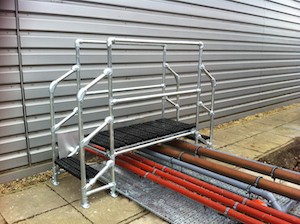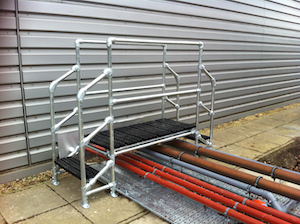View the Kee Safety entry on BPindex
View the Kee Safety step-over platform product details
Navigating a roof across pipework, low level walls, changes in levels and installed equipment can present a problem. Entire areas of the roof space can become inaccessible making maintenance difficult or even impossible. Ben Rutter from Kee Safety discusses why step-over platforms provide the perfect solution.
According to the Health & Safety executive (HSE), working at height remains one of the biggest causes of fatalities and major injuries. At the same time, slips and trips are the most common cause of major injuries at work and can happen almost anywhere. 95% of major slips result in broken bones and they can also be the initial cause for a range of other types of accident such as a fall from height.
In February this year, following a 12-month enquiry, the All-Party Parliamentary Group (APPG) on Working at Height published a report entitled, ‘Staying Alive: Preventing Serious Injury and Fatalities while Working at Height’. This new report sees the APPG call upon the Government and industry to review the working at height culture, with the aim of cutting down the number of deaths and accidents caused by falls.
Contractors are under pressure to ensure the safety systems are in place to prevent slips, trips and falls from height. This is apparent on flat roofing projects. Many flat roof tops feature pipework, HVAC systems, conduits, skylights and other obstacles, and with maintenance teams regularly accessing these types of roofs to carry out work on the building services equipment, it’s easy to see why accidents can easily happen. If a safety system isn’t in place, getting around these obstacles often ends up with workers climbing, hopping, and jumping over these objects.
 For these type of obstacles, step-overs are the best solution. They provide a safe and secure access platform, and, since roof structures tend to not change, these systems can be left in place indefinitely so that there is no need to fix the problem every time someone has to access the roof.
For these type of obstacles, step-overs are the best solution. They provide a safe and secure access platform, and, since roof structures tend to not change, these systems can be left in place indefinitely so that there is no need to fix the problem every time someone has to access the roof.
Most of these structures can be installed in minutes and can be fully customised to what is required. From a small ramp that crosses a run of conduit, to a platform with stairs that bridges two roof sections, to the walkways needed to get to and from access points, pre-fabricated, modular access platforms are available to solve all of these issues.
With adjustable step sections, and non-penetrative fixing options, step-overs have the inherent flexibility to not only protect those accessing the roof, but to also protect the roof sheet from unnecessary foot traffic and potential damage by providing a clearly defined access path. There is the ability to meet virtually any design requirement, with the end result always being a safe, secure and compliant access platform.
Constructed using tubular fittings, each fitting incorporates an internal set screw to lock the respective fitting safely and securely onto the tube to create a strong, stable and safe structure. This method eliminates the need for time-consuming welding or specialist skills or tools, saving contractors both time and money on site.
When selecting this type of solution, contractors should make sure that it complies with EN 14122-2/3:2016. This standard defines the requirement for non-powered fixed means of access in and around buildings where access to machinery and plant or where access and egress is required. It deals specifically with guardrail details such as materials, loading and deflection, alongside tread placement with regards to depth, rise, going and pitch with requirements for dimensional, positional and operational considerations for the work platform.
For more information, visit www.keesafety.co.uk

